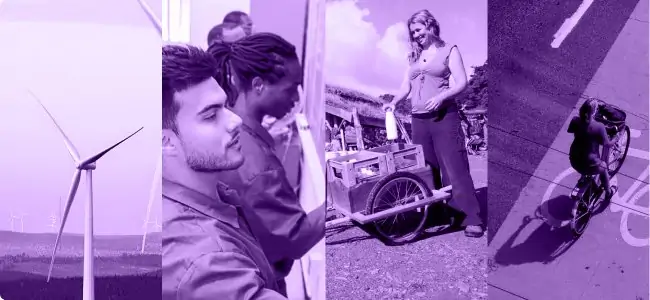She’s coming for the mayor’s office.
by Hannah Murphy Winter
It’s 7 o’clock on August 5, the night of the Seattle primary election. Most local candidates are hosting their election night parties at industrial-style bars and breweries across Capitol Hill or Ballard, but not mayoral hopeful Katie Wilson. This room in Beacon Hill looks like it was set up for Bingo Night, or a particularly hype, politics-themed children’s birthday party.
And it actually is a particularly hype, politics-themed children’s birthday party. Wilson is sitting at a table, pinning the tight bun her hair is always tied into, when someone carries over a little girl in a cotton floral dress and sets her down. Josie is celebrating her second birthday tonight, watching the scene from the floor, wide-eyed and a little over it.
Balloons are taped to the wall and tied to the backs of plastic chairs. Streamers hang haphazardly by her yellow campaign signs.
Campaign staff, volunteers, and a handful of other candidates for city office mill around the open space, snacking on hummus and veggies and cashing in their drink tickets for beer and wine. A truck outside is selling pizza, a nod to an early campaign video about why a slice can be as much $8 in Seattle now. It’s all so scrappy, just like her.
At 8 p.m., the packed room quiets. The ballot count will drop any minute. For months, Wilson was fighting a narrative as much as she was fighting incumbent Mayor Bruce Harrell. He was entrenched, unbeatable, the institution. She was the progressive upstart without a shot. Early polling showed that voters liked her message, but were barely familiar with her name. Refreshing the King County election website on their phones, the room was eager to know if that narrative was right.
At 8:05, a woman yells: “Katie’s number one!”
The crowd erupts.
Wilson walks to a podium at the back of the community center through a chanting crowd that’s already closing in around her. Her bag is still on her shoulder and she’s wordlessly looking toward her team in the crowd.
When the cheering quiets down, she brings the mic to her mouth, and looks over to her campaign staff. “Are we really at 46 percent?”
The crowd roars.
“Wow, that’s a lot better than I expected,” she says.
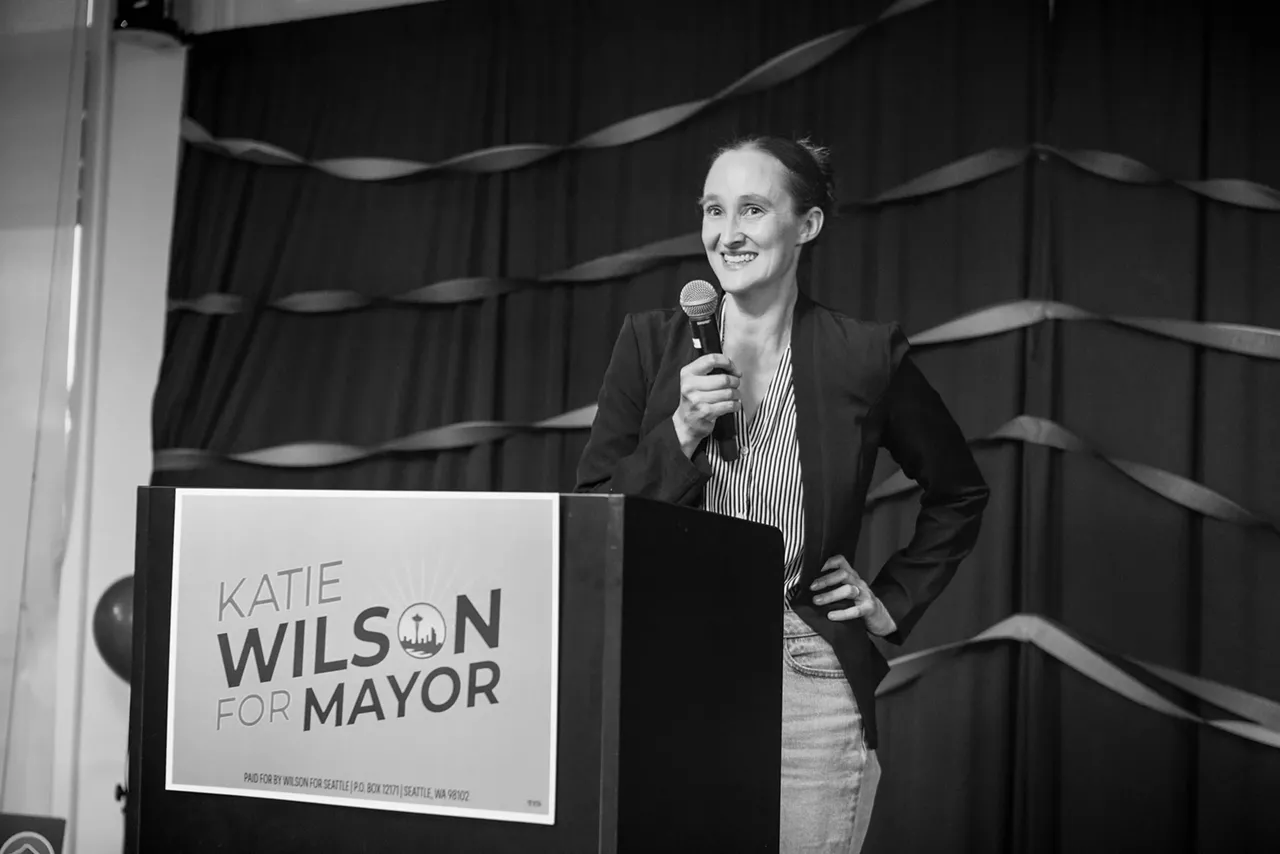
Wilson finding out she beat Harrell in the primary. BILLIE WINTER
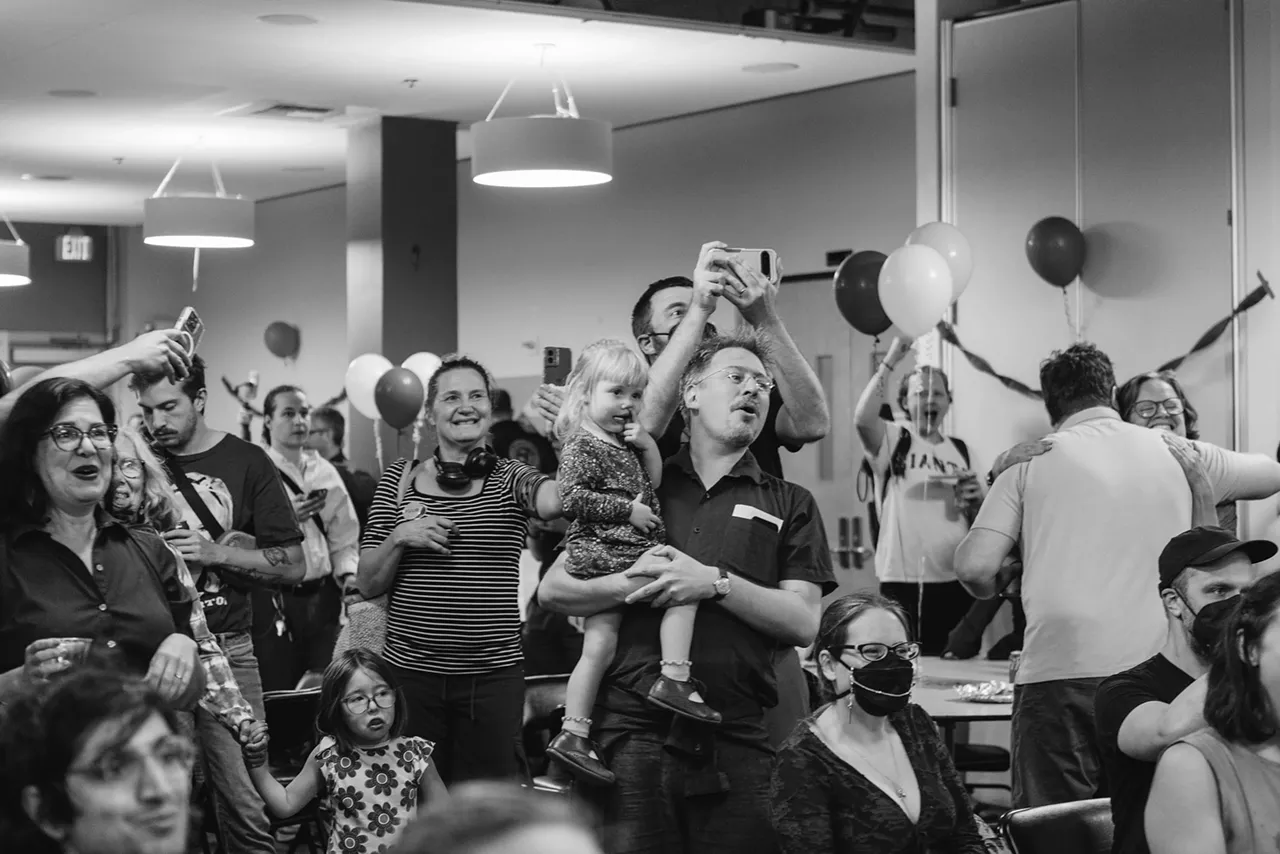
Wilson’s husband celebrates with their daughter. BILLIE WINTER
The general rule of Seattle politics is that older moderates vote early, and younger progressives vote right before the deadline. The first ballot drop skews conservative. An hour earlier, Wilson told me she hoped to be a few points behind Harrell that night, catch up in the next few days, and overtake him in the end.
She didn’t expect to be almost a point and a half up.
“Okay, so we’re headed to the November ballot,” she says to the room.
In the end, she took more than 50 percent of the total vote, leaving Harrell almost nine points behind her.
***
The Friday after election night, I met Wilson at her campaign office in the Smith Tower: a room of mostly empty desks that’s 20 by 20 feet, at most. She’d shared this office with city attorney candidate Rory O’Sullivan and city council candidate Jamie Fackler, but neither of them got through the primary. She’d spent the last four days catching up on the 150 “congratulations” texts from everyone she knew, and quite a few people she didn’t know. Frontrunners are more interesting than upstarts.
Sitting at a desk, looking toward City Hall Park, she started from the beginning.
Wilson was raised in Binghamton, New York, in a home steeped in academia. Both of her parents were evolutionary biologists. Her mom, Anne Barrett Clark, studied birds, and she specialized in redwing blackbirds when Wilson was in grade school. “I have a lot of memories of tramping around her field site, helping her to put little bands on baby birds, or weigh them, measure them,” Wilson says. Today, her mom is focused on crows’ social behavior.
I ask about her dad.
“He’s actually quite well-known,” she says, uncomfortably.
In the 1970s, the biologist Richard Dawkins published The Selfish Gene, a blockbuster pop-sci hit that argued that our very genes, the genes of animals, of plants, all strive for immortality. Living things are completely governed by our own self-preservation. And as a result, everyone and everything is selfish by design. His arguments have been co-opted by every libertarian and cheating ex-boyfriend to explain their rugged individualism for the 50 years since.
Wilson’s dad, David Sloan Wilson, made his career arguing against Dawkins’s theory.
Essentially, he developed a counter-theory that altruism—rather than selfishness—can be a product of natural selection. His publications on the subject span from 1980 to 2022. And in his 2011 book, The Neighborhood Project: Using Evolution to Improve My City, One Block at a Time, he helps find practical ways that evolutionary biology can be applied to the world around you.
“The thrust of my dad’s work is showing that, from a scientific, biological point of view,” Wilson says, “noble, moral motivations are real. And that there’s an evolutionary basis for that.”
It’d be easy to try to draw a connection between Wilson’s dad’s work and her own politics. A household driven by the belief that community-mindedness is inherent to our biology seems like it could create little leftists straight out of the womb.
But when I ask Wilson, she tells me I’m off base. Yes, her household shaped her politics. but not in the way I thought.
She took three essential gifts from her parents, and in spite of them: a refusal to trust authority just because it’s authority, an ambivalence to the ideas of status and money, and a refusal to follow her parents into the world of academia.
From her vantage point, her parents seemed so separated from their subjects, and she wanted to make a tangible impact. “They were genuinely in it because they want to understand how the world works,” she says, but “they were in this ivory tower, right? They’re thinking about things, but there’s a lot about the world that I think they didn’t understand. And that I didn’t understand either, because I hadn’t been in it.”
In high school in Binghamton, she started to get involved in the anti-consumerist, anti-globalist movements of the ’90s, the way that teenagers do when they have a strong sense of moral justice and nowhere to put it. When she was 15, she cofounded a local chapter of Food Not Bombs, a sort of freegan, and vegan, soup kitchen that made free meals for the community.
That’s where she met her now-husband, Scott Myers. At the time, Myers was a self-described punk, with a touch of rockabilly. “My hair was greased up like Elvis or something.” And the chapter was serving food at an animal rights protest against a circus that was coming through town. His first impression of Wilson? “Well, she was wearing Birkenstocks and socks,” he says. “I remember thinking, ‘This is a weird person. I’ve never met someone like this.’”
When I ask Myers if, in any way, she’s still the same person he met that day, he, like anyone who’s known someone for 30 years, struggles to find an answer that could fairly capture decades of growth. But he’s easily able to paint one clear throughline from that teenager at the circus: “If she’s ever ambitious,” he says, “it’s never for her own reasons. It’s always about trying to do the most good for the most people.”
The two went to different high schools, but that meeting started a relationship between the unlikely pair that would last, off and on, through their adult lives. (Wilson and Myers describe their teen romance as “a complicated, adolescent relationship” and “tortured, teenage, fits and starts,” respectively.)
At that point, Wilson still appeared to be on the same academic track as her parents. She graduated from Binghamton High School as the salutatorian, and headed straight to Oxford University to study philosophy and physics (“to get to the bottom of things,” she says). But when it came time to graduate, Wilson considered her parents’ ivory tower again. She didn’t want to be “looking down on the world and trying to understand it,” she says. “I wanted to get my hands dirty.”
And this is where her rejection of her parents’ careers in academia came to a head: Six weeks before graduation, Wilson dropped out of college.
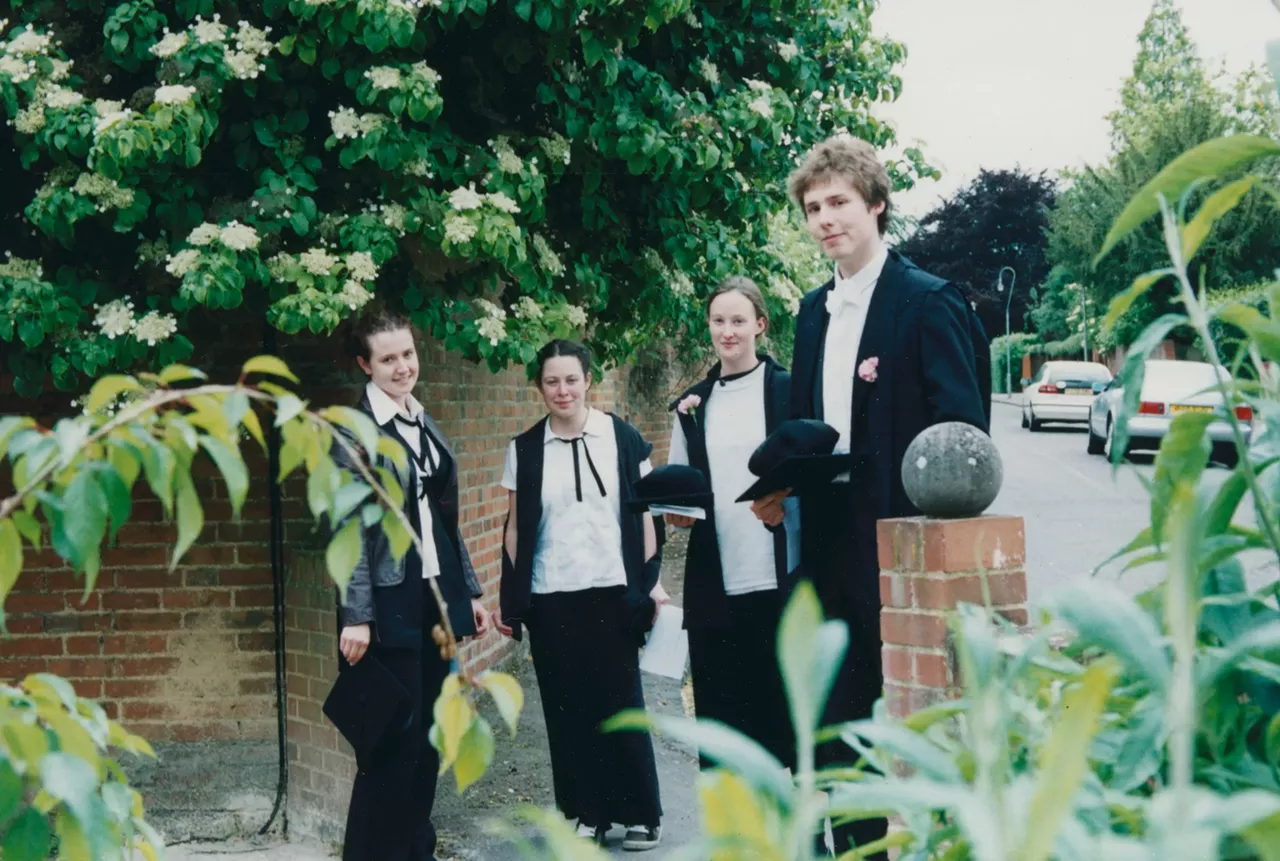
Wilson (second from right) after her first-year exams at Oxford. COURTESY OF KATIE WILSON
“As I got toward the end of my time at Oxford—that’s the time when people are thinking about what they do next, right? Are you gonna go and apply for graduate school or get a job with McKinsey? And so as I got into my final year, as I was having those thoughts, it was like, ‘Well, I’m not doing any of that.’” And so she decided to make sure that that wasn’t an option.
“I have to admit I was at least a little bit of a bad influence on her,” Myers says, sheepishly. While Wilson was in college, he’d gotten his GED, moved to the Bay Area, and gotten deeper into the protest movements of the early 2000s. His life looked drastically different than hers: He was busking on the BART and volunteering at an Indian reservation. “I’m happy it didn’t wreck her life,” he says. “She had to work jobs that she probably wouldn’t have worked, and get a different perspective on life, and on how a lot of people live and make a living. It might look less prestigious, but I think it’s shaped her a lot… But if my daughter did it, I would be like, ‘Don’t do that.’”
“No regrets,” Katie tells me. “And my parents have forgiven me for it, at this point,” she says, in a way that makes me wonder if it really did take until she was in her 40s.
***
Dropping out of college did exactly what she wanted it to do. Like flipping a railroad switch, she veered away from a life that seemed to be inevitably barrelling toward prestige and academia, and into the life of someone who wasn’t raised for Oxford from birth.
Wilson and Myers got married in 2004 and took what they call a “Greyhound Honeymoon,” busing from city to city to decide where they would start their new life. That city, it turns out, was Seattle.
They landed here because, at the time, it was affordable, and because it had an accessible university library system where they could continue their education on their own (which Wilson describes as sometimes “inefficient and weird,” but also a valuable way to fill in some of the gaps that her two majors left).
Their youthful self-education was driven by a central question: Why did the political movements they were a part of in the ’90s and aughts die in the water, and what did it take to make a social movement successful? They’d been involved in the Wolrd Bank protest in 2000, the anti-war movement after the invasion of Iraq, “and we were both somewhat disillusioned with the results of those movements,” Wilson says. “And so we made a joint decision to figure out, ‘How do we change the world?’”
They knew the key was organizing worker power. “We were inspired by the labor movement of the 20th century and the Civil Rights Movement,” she says, “but the world today is not like it was in the 1930s and the 1960s.” What was 2004’s organizing principle? Could they organize Walmart and other big box stores? Could they organize service workers?
But in the meantime, they had to make a living. In Seattle, Wilson’s first job was as an office assistant at an environmental science laboratory, followed by a brief stint at the Seattle Yacht Services, buffing hulls, painting boat bottoms, and repairing yachts.
But her mainstay for a few years was construction. She started out as an apprentice carpenter with a general contractor in Eastlake, renovating apartments. “This was a shady fucking worksite,” she says. The building itself was probably made as a hotel for the World’s Fair in 1962, she says, and then converted into apartment buildings. This time, their crew was turning studio apartments into one-bedrooms and flipping the building. “They were so cheap, they didn’t even buy us ladders,” she says. “So if we were doing work on the ceiling, we had to stand on five-gallon buckets.”
Looking for a construction job that felt less like a death trap, she emailed Mike Cain, a local contractor who had posted an ad on Craigslist looking for a construction laborer. She wrote:
I have some experience with framing, and I am proficient with both a hammer and a nailgun. I did a lot of drywall (both new and repairs), taping, mud, spray texture, painting (spray, roller, and brushwork), cheap flooring, and window trim and baseboard installation. I did demolition and, in general, a lot of carrying heavy things from one place to another… I am strong and competent and I am a hard worker. I learn very quickly, and I have a sharp eye for detail when necessary.
She ended the email: “I have my own tools - a cordless drill, a small skil-saw, a carpenter’s belt, lots of hand tools, and personal safety gear. I have a drivers license, but no car. I commute by bike and I live in North Seattle, which is within easy biking distance from University Village. I am very punctual and reliable…I would be available to start work immediately.” She asked for $15 an hour, but she’d take $12 “for a trial period.”
When I ask Cain what he remembers most about her, he tells me about their face-to-face interview, at the job site. He knew she’d recently moved across the country, and he remembers asking her what she was doing in Seattle. “I’m going to unionize Walmart,” she told him. “That was so cool,” he says. “‘You got the job,’ [I told her], just on the basis of that. Just her spirit and her spunk and everything. I was like, you look like you can lift 50 pound things over and over and over again all day.”
Wilson ended up working for Cain for six months. And she didn’t unionize Walmart. Instead, it took many patient years before she found an entry point to start organizing worker power in Seattle. In 2011, after the Great Recession pushed King County to take up austerity measures, the county was planning to cut Metro bus routes—a direct hit on working people.
“It was personal to us,” Wilson says. “We didn’t have a car, so it legit affected us. And then we just thought, ‘Okay, let’s organize transit riders.’”
Wilson and Myers would eventually run a number of successful campaigns, working within the complex ecosystem of city budgets, policy makers, and communities. When these two now-seasoned organizers talk about their first campaign, they can only see the mistakes they made with that first effort. At the time, “we didn’t know the details of real-world politics,” Myers says. “The political stuff we were in when we were younger was like: make a banner, go to a protest, make a pot of food. We didn’t know anything about taxes and revenue and any of this stuff, so we just dove into it.”
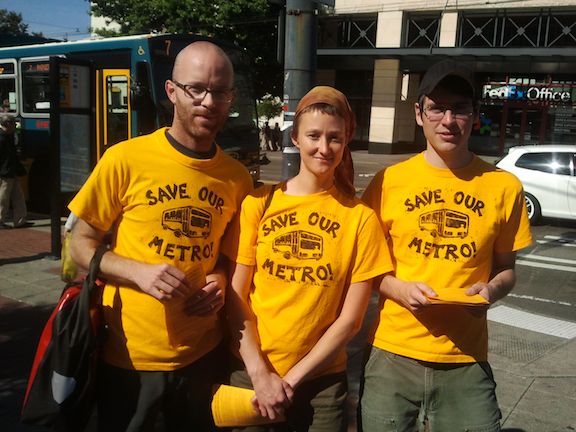
Wilson’s first campaign (and yes, they still have these shirts). COURTESY OF KATIE WILSON
For the “Save Our Metro” campaign, Myers says, “we spent a whole week just flyering down on Third Ave.—the big bus corridor—putting up posters and talking to bus riders. We didn’t know how to organize or anything, so we just thought, ‘Oh, we’ll do this, and all these people will show up to our rally.’ And then like 30 people showed up.”
They hadn’t even learned to collect contact information from protesters yet (“We thought that was cynical, or something,” Myers says). But some of the protesters wanted to keep fighting for their transit system. “It was a lot of figuring it out as we go,” Myers says. “It took us a year to figure out how to write a constitution and bylaws.”
And that’s how the Transit Riders Union was born.
***
For someone who has been in politics, but not a politician, for years, Wilson is rather private. The Transit Riders Union is where Wilson’s story starts for Seattle’s political left. Her brainy family, walking away from prestige, her blue-collar jobs, the long journey of political discovery—it’s not just less a part of her campaign than pizza, it’s not part of her campaign at all.
The first glimpse I got of just how much we didn’t know about Katie Wilson was at a political forum called Candidate Survivor. Hosted by The Stranger and the Washington Bus, the forum includes a talent portion, where candidates are asked to perform. Wilson walked on stage with a guitar over her shoulder and a harmonica in a holder around her neck. She used to busk at Pike Place Market, she told the crowd. It’d been 10 years, though, she said, “so give me some grace here.” And she dove into a bluegrass standard.
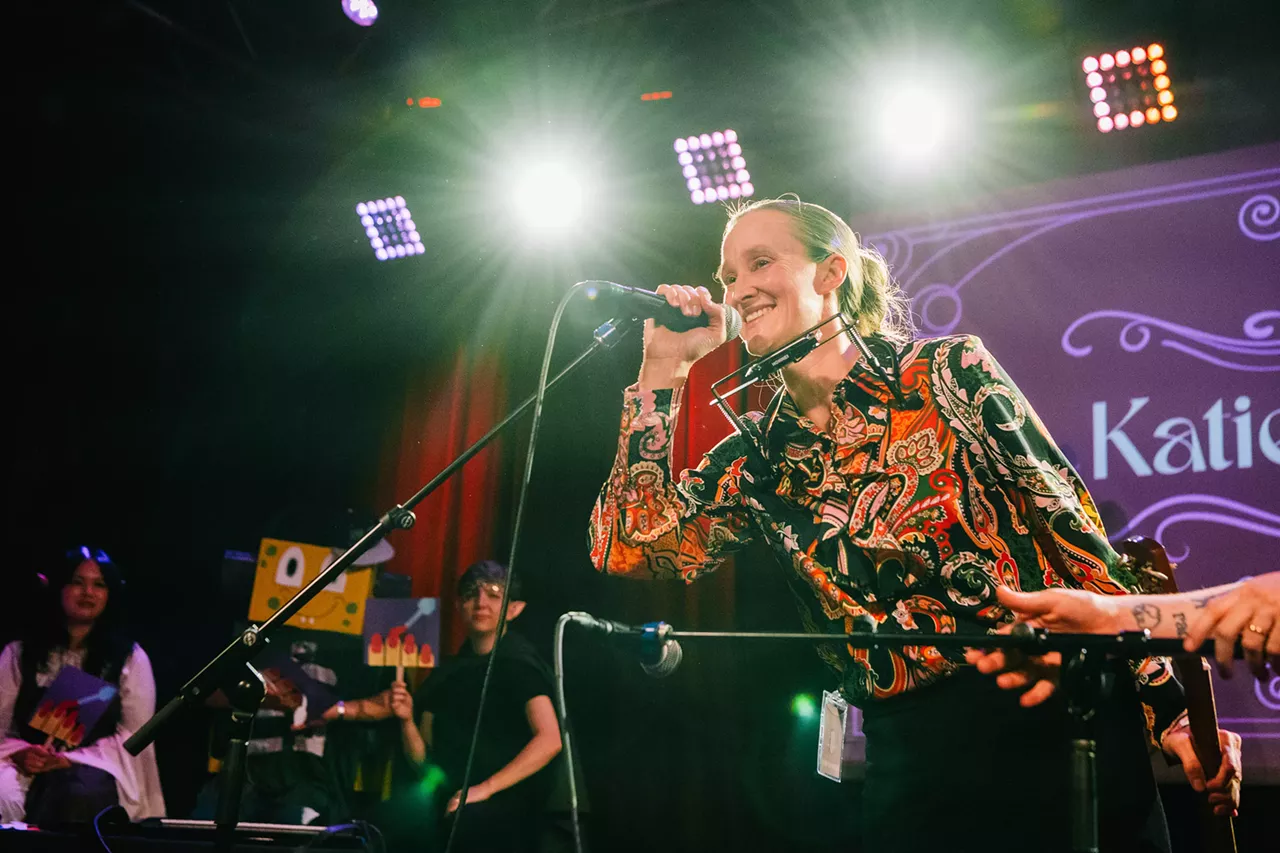
Wilson at Candidate Survivor in July. WEST SMITH
How could someone running for Mayor of Seattle go months without telling voters that they’d been a busker at Pike Place Market? It’s the kind of narrative that politicos fall over themselves for. The stories that tell voters that this person really is a real person, not just a pile of ambition in a suit.
That’s a choice. Wilson has been running her campaign like she’s campaigned for minimum wage, progressive revenue, and renter protections. They were never centered on a person or personality, because that wasn’t the point. It was to build coalitions, find where groups had common goals, and pull power out of people by showing them that they agree with one another. That’s her special sauce. When her campaign broke out into the national media, The Nation magazine said she “launched her campaign like a social movement,” an exercise in “new progressive pragmatic political power.”
And it’s certainly not the only way she breaks from the Seattle mayoral tradition. Former mayor Jenny Durkan owned a $7.5 million mansion on Whidbey Island. Harrell bought his Seward Park home in 2011 for $1.4 million. Ed Murray owned his home on Capitol Hill and a vacation home on the Peninsula. Wilson and Myers rent a one-bedroom apartment in Capitol Hill. When they moved there in 2018, it was the first time in years they didn’t have housemates—a luxury they were only able to afford because that year, the Transit Riders Union was able to start paying her for her work. The apartment has four rooms: a kitchen, a living area, a bedroom, and a bathroom. Maybe four and a half, if you consider the small living room nook where Josie’s toys and clothes are tucked away.
Her building was built in the 1920s—a three-story walkup that was meant to help address a severe housing shortage at the time. It’s full of simple, original details: arched doorways, natural wood trim, and a built-in linen closet. And that’s just the bones. Myers was laid off during lockdown, and he used that time to single-handedly turn the apartment into an old-world, maximalist dream—ornate wallpaper cornstarched to the walls, painted ceilings, saturated velour couches. Their kitchen has two refrigerators and two ovens because Myers regularly makes homemade bagels and pizza. It’s all DIY and secondhand. And it works.
But it’s also so small. Two people can’t be in the kitchen together without getting tangled. Their mattress sits on the floor. Josie sleeps in a Pack ’n Play in their bedroom until they go to sleep. Then when it’s time for them to go to bed, they carefully move her, Pack ’n Play and all, into the living room, where she sleeps for the rest of the night. They haven’t figured out what happens when she outgrows the Pack ’n Play, but they’re confident they will. They do a lot with a little.
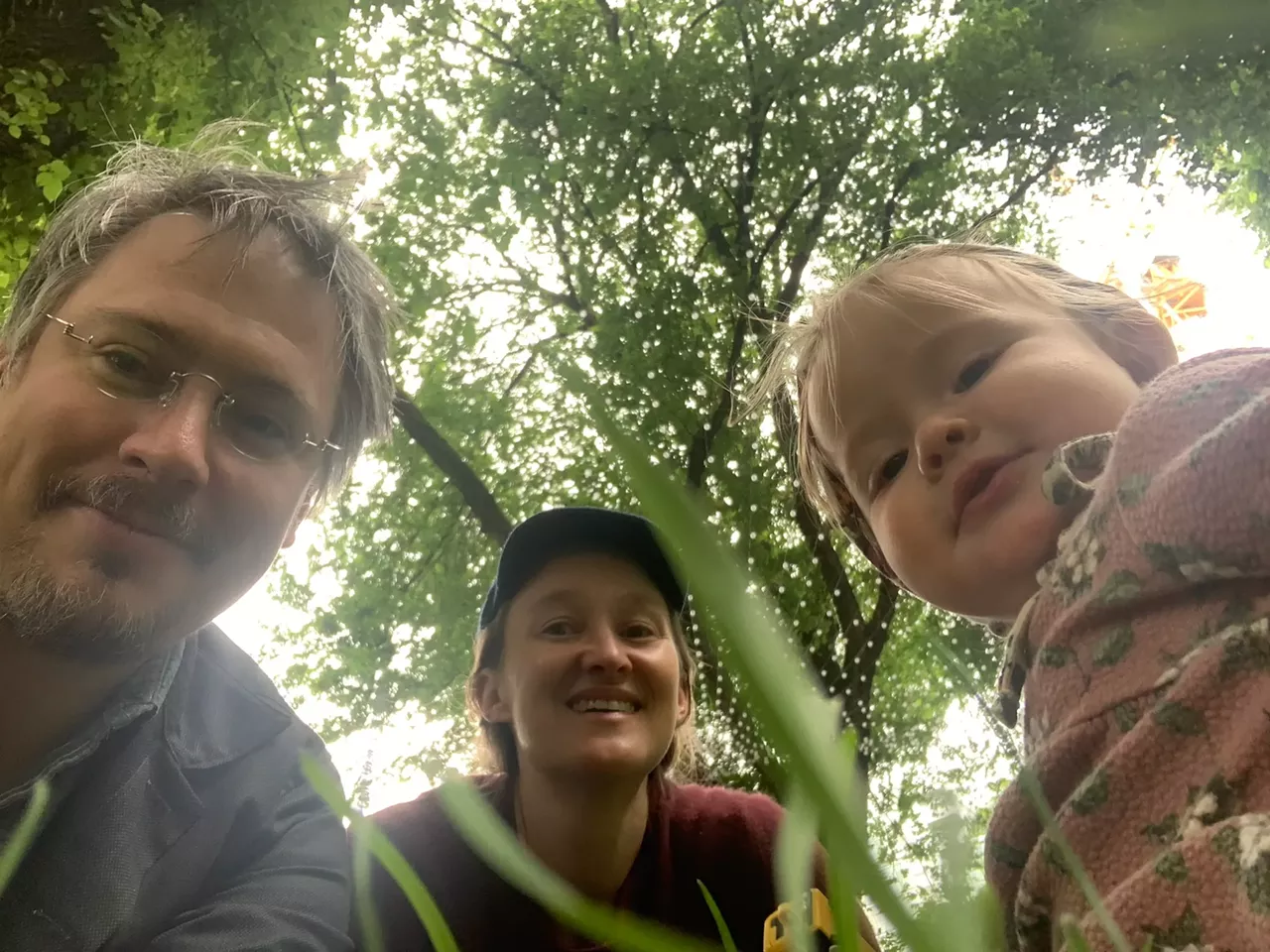
Wilson and Myers haven’t figured out what they’ll do when Josie outgrows her Pack ’n Play. COURTESY OF KATIE WILSON
The same can be said of Wilson as an organizer. She knows that understanding the world—whether in academia or in politics—is about knowing what she doesn’t know. And she follows that by finding the one person who knows the most about that thing, and makes them a part of her coalition. That’s how she got the city to buy in to subsidized Orca cards, renter protections, raising the minimum wage—every seemingly pie-in-the-sky victory that the Transit Riders Union won.
Until her mayoral campaign, she’d never had a team—even a small one—that was fully dedicated to the cause. “You need to herd cats, to get them all doing their thing. And when it’s a coalition, then there’s lots of organizations who are being paid to do the work as part of their time,” she says.
The challenge, then, was taking the sliver of attention that that incredibly talented group of people could give to her cause, and making it as effective as possible. And it worked. Like she told me the day before she announced her campaign for mayor: “I would be happy to put my legislative record up against Bruce Harrell’s any day of the week.”
Wilson decided to run for mayor after Harrell opposed the social housing proposition that ultimately got almost two-thirds of Seattle’s vote. Wilson saw it as the biggest fumble in his term, and a clear sign that Harrell was out of touch with the voters in Seattle. And maybe that meant he was vulnerable to a progressive challenger. She went home that night and told Myers what she was thinking. “I told her, ‘If you run for mayor, I’ll divorce you,’” Myers says. “But we stayed up all night long talking about it, and by the end of the night, I told her, ‘If you don’t run for mayor, I’ll divorce you.’”
“Honestly, I’m more worried about my ability to put together a mayoral wardrobe than I am running the city,” she told me, gesturing at the combination of Goodwill finds she was wearing that day. “I know so many highly skilled, competent people, people who’ve worked in City Hall for decades. I’m so confident in our ability to assemble this team, and really excited about it.”
The people she’s worked with over the last decade reflect that same confidence. When she launched her campaign, scores of people who’d worked with the Transit Riders Union sang her praises. And of course, Cain, the contractor, gave her the most glowing endorsement of all. “Katie Wilson is smart, tough, running for mayor…and a former Mike Cain Construction employee,” he wrote on Facebook after she announced her campaign. “She was outstanding at moving heavy stuff around job sites.”
When I talked to Cain, he talked about Wilson’s intelligence, her spunk, and how interested he was in how she found herself working in construction in Seattle. “Especially since she’d just dropped out of Oxford,” I added. The voice on the other side of the phone was silent. “I actually didn’t know that,” he said, with a note of surprise.
There’s a lot to be surprised by from Katie Wilson. Her ability to play guitar and harmonica at the same time. Her taste in home decor. That her favorite movie is Orson Welles’s 1965 Chimes at Midnight. I’m confident her parents and her Oxford professors have been floored by her at least once.
When I first arrived at her apartment, she popped her head out of the doorway and waved me in. Her hair is usually tied into a careful knot at the back of her head with a series of bobby pins. But when I got there, her hair was still down. To my surprise, when it wasn’t wound into her signature bun, it fell almost all the way down her back.
While I watched her pin her hair up, I was reminded of the final impression Myers wanted to leave me with when we spoke. “I don’t pay very close attention to all the media. She might seem, on the exterior, staid and unflappable,” he says. “But inside, she’s a really passionate person,” he says. And she’s coming for the mayor’s office.


 Wilson finding out she beat Harrell in the primary. BILLIE WINTER
Wilson finding out she beat Harrell in the primary. BILLIE WINTER
 Wilson’s husband celebrates with their daughter. BILLIE WINTER
Wilson’s husband celebrates with their daughter. BILLIE WINTER
 Wilson (second from right) after her first-year exams at Oxford. COURTESY OF KATIE WILSON
Wilson (second from right) after her first-year exams at Oxford. COURTESY OF KATIE WILSON
 Wilson’s first campaign (and yes, they still have these shirts). COURTESY OF KATIE WILSON
Wilson’s first campaign (and yes, they still have these shirts). COURTESY OF KATIE WILSON
 Wilson at Candidate Survivor in July. WEST SMITH
Wilson at Candidate Survivor in July. WEST SMITH
 Wilson and Myers haven’t figured out what they’ll do when Josie outgrows her Pack ’n Play. COURTESY OF KATIE WILSON
Wilson and Myers haven’t figured out what they’ll do when Josie outgrows her Pack ’n Play. COURTESY OF KATIE WILSON



